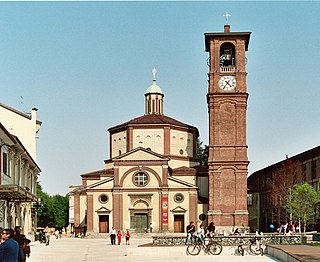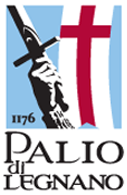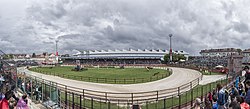
The battle of Legnano was a battle between the imperial army of Frederick Barbarossa and the troops of the Lombard League on 29 May 1176, near the town of Legnano, in present-day Lombardy, Italy. Although the presence of the enemy nearby was already known to both sides, they suddenly met without having time to plan any strategy.

Legnano is a town and comune (municipality) in the province of Milan, about 20 kilometres (12 mi) from central Milan. With 60,259, it is the thirteenth-most populous township in Lombardy. Legnano is located in the Alto Milanese and is crossed by the Olona River.

Associazione Calcio Dilettantistica Legnano, commonly referred to as Legnano, is an Italian football club based in Legnano, Lombardy. Founded in 1913, Legnano played three seasons in Serie A and a total of eleven seasons in the top tier of the Italian football league system.

A carroccio was a large four-wheeled wagon bearing the city signs around which the militia of the medieval communes gathered and fought. It was particularly common among the Lombard, Tuscan and, more generally, northern Italian municipalities. Later its use spread even outside Italy. It was the symbol of municipal autonomy. Priests celebrated Mass at the altar before the battle, and the trumpeters beside them encouraged the fighters to the fray.

Aribert was the archbishop of Milan from 1018, a quarrelsome warrior-bishop in an age in which such figures were not uncommon.

Alberto da Giussano is a legendary character of the 12th century who would have participated, as a protagonist, in the battle of Legnano on 29 May 1176. In reality, according to historians, the actual military leader of the Lombard League in the famous military battle with Frederick Barbarossa was Guido da Landriano. Historical analyses made over time have indeed shown that the figure of Alberto da Giussano never existed.
San Giorgio su Legnano is a comune (municipality) in the Metropolitan City of Milan in the Italian region Lombardy, located about 20 kilometres (12 mi) northwest of Milan.
The Canegrate culture was a civilization of prehistoric Italy that developed from the late Bronze Age until the Iron Age, in the areas that are now western Lombardy, eastern Piedmont, and Ticino. Canegrate had a cultural dynamic, as expressed in its pottery and bronzework, that was completely new to the area and was a typical example of the western Hallstatt culture.

The Company of Death is the name used in the historical literature of English language for two related chosen tactical corps, two selected bands of warriors, entrusted to guarantee the cohesiveness and efficiency in battle of both the Milanese and Lombard League's militias through their bond by oath to the defence of the Milanese Carroccio, the wagon on which the standard of the Lombard allies stood.

The oath of Pontida, according to tradition, would have been a ceremony that would have sanctioned on 7 April 1167, in the abbey of Pontida, near Bergamo, in Italy, the birth of the Lombard League, or of a military alliance between the municipalities of Milan, Lodi, Ferrara, Piacenza and Parma aimed at the armed struggle against the Holy Roman Empire by Frederick Barbarossa.

The Basilica of Saint Magnus is the principal church of the Italian town of Legnano, in the province of Milan. It is dedicated to the Saint Magnus, who was Archbishop of Milan from 518 to 530. The church was built from 1504 to 1513 in the Renaissance-style designed by Donato Bramante. The bell tower was added between the years 1752 and 1791. On 18 March 1950, Pope Pius XII named the Basilica of San Magno a minor basilica.

The Palio di Legnano is a traditional event generally held on the last Sunday of May in the City of Legnano, Italy, to recall the Battle of Legnano held on 29 May 1176 by the Lombard League and the Holy Roman Empire of Frederick Barbarossa. This Palio is composed by a medieval pageant and a horse race. Until 2005 the whole event was named Sagra del Carroccio.

Legnano, an Italian municipality of the Metropolitan City of Milan in the Alto Milanese, has a recorded history from the first mention of the Legnarello district to the present day.

The contrade of Legnano are the eight historical subdivisions into which the city of Legnano, in Lombardy, in Italy, is divided. They participate annually in the Palio di Legnano.

The Visconti Castle is a medieval fortification that stands south of Legnano on a natural island in the Olona River. It has also been known as the castle of San Giorgio since the 13th century. The architectural complex is located on Viale Toselli, between Castello Park and Piazza I Maggio.

The term Alto Milanese, also called Altomilanese, is used to refer to the territory of Lombardy that includes the northwestern part of the metropolitan city of Milan, the southern part of the province of Varese and some municipalities in the southwestern part of the province of Como. It largely corresponds with one of the Italian provinces planned in the past: the province of Seprio. The Alto Milanese can be divided into four zones having their respective major cities as their main centers: the Bustese, Legnanese, Gallaratese and Saronnese. The major rivers of the Alto Milanese are the Olona and the Ticino, while among the noteworthy streams are the Arno, the Tenore, the Bozzente, the Lura, the Rile, and the Strona.

Palazzo Leone da Perego is a historical building in Legnano. It was rebuilt in 1898 preserving some decorations of the previous medieval building of the same name. Located a few steps from the Basilica di San Magno, it has two entrances, one in via Magenta and the other in via Girardelli. It is named after Leone da Perego, archbishop of Milan who died in Legnano in 1257. Together with Palazzo Visconti it forms the "Corte Arcivescovile".

Palazzo Malinverni is a historical building in Legnano. It is the seat of the Town Hall (building) of the city. It is located in the central Piazza San Magno, next to the homonymous Basilica and was inaugurated on 28 November 1909, during the city's period of greatest growth — industrial and demographic.
WolseleyItaliana (official name: Società Anonima Wolseley Italiana – Officine Legnanesi Automobili Wolsit, also known by its trade name Wolsit, was an Italian company active in automobiles, aerospace, motorcycles, and bicycles, operating in Legnano between 1907 and 1927.
This is the history of Associazione Calcio Legnano, commonly referred to as Legnano, an Italian football club based in Legnano, Lombardy. The club last played in Serie A in 1954 and has since played in the lower divisions of Italian football.




















